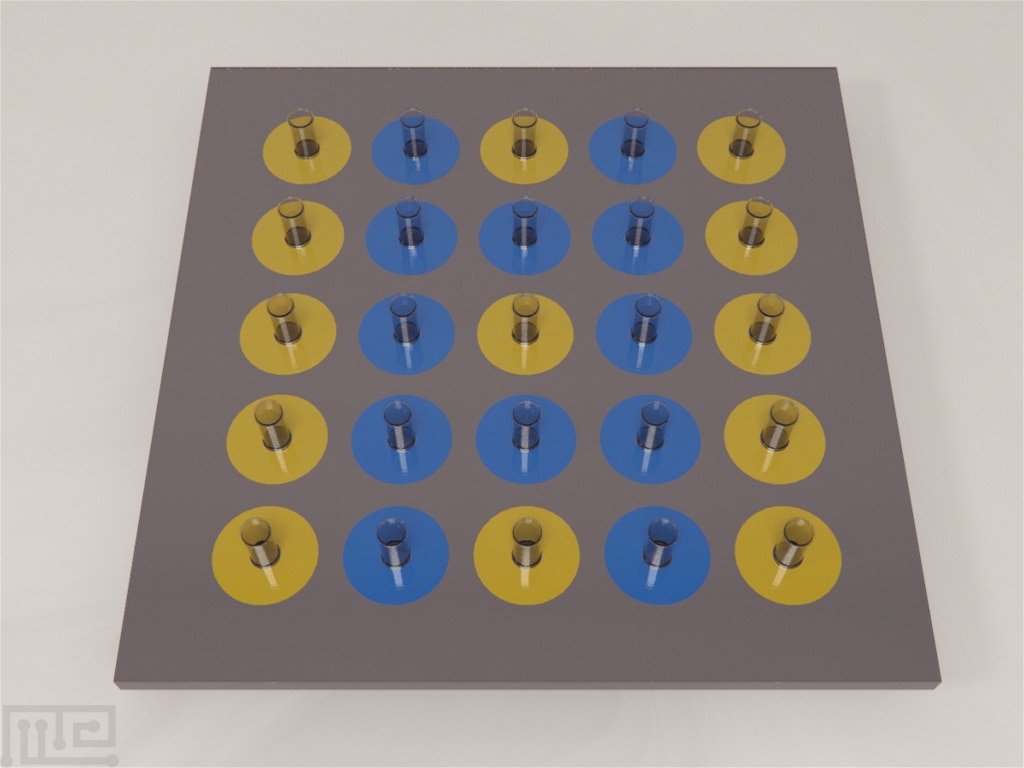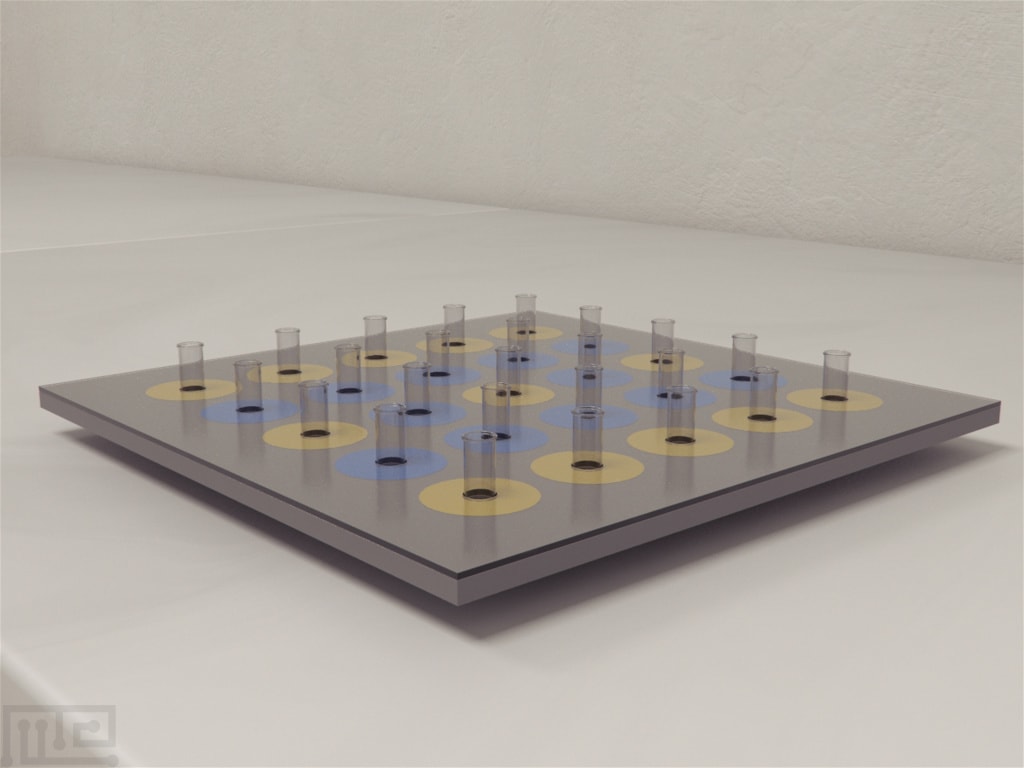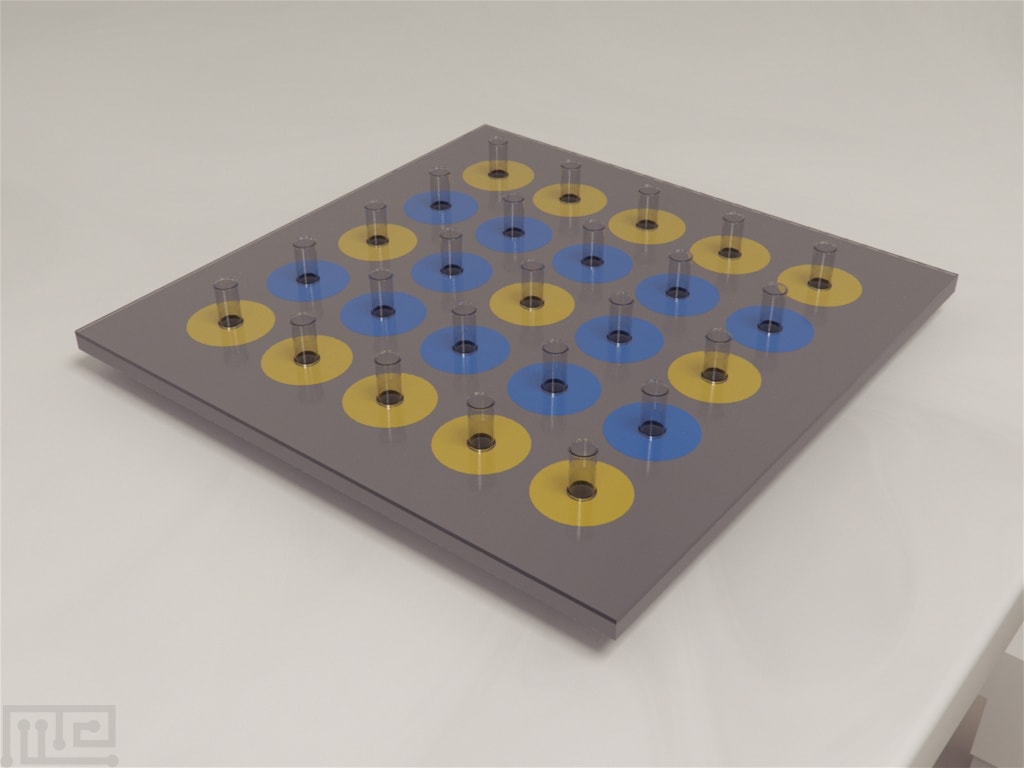Description
Bees can learn to associate colors with a sugar reward in a setting closely resembling a natural foraging situation. This apparatus allows the researcher to pair sucrose (or other solutions) in an artificial flower patch to study reward expectations.
This artificial flower patch consists of 24 Eppendorf tubes (4 cm deep) that function as flowers. This is included in your order. They are regularly distributed over the surface of a foraging arena. This arena consists of two superposed acrylic plates, creating 24 holes of 1cm in diameter. The lower plate is created with a 0.7-cm thick opaque acrylic plastic, while the upper square was a 0.2-cm thick transparent Plexiglas.
The tubes are placed inside the holes and raised 1.8 cm above the upper surface of the transparent Plexiglas. 24 color signals, 12 yellow and 12 blue, can be are visible to the bees through the upper transparent Plexiglas plate.
The flowers were held by the upper surface of the patch and the colored circles were set below this surface, both the flowers and their corresponding visual stimuli could easily be replaced between trials.
Price & Dimensions
Bee Reward Expectations
$ 1390
Per Month- Foraging arena: L: 28 cm x W: 28 cm
- Two superposed acrylic plates with 24 holes of 1cm in diameter
- Upper plate: 0.2cm acrylic clear acrylic plate
- Lower plate: 0.7-cm thick grey acrylic plate
- Artificial flower patch: 4cm deep, 480 eppendorf tubes
- Color: diameter of 3.8 cm. 24 colored circles
Documentation
Introduction
Social Y-Maze is a modification of the Y-Maze (see also T-Maze). The apparatus is used to access the social interaction choices in rodents. Impairments in social interactions can arise from neuropsychiatric disorders such as Schizophrenia, Bipolar disorder, and neurodevelopmental disorders such as Autism Spectrum disorder (ASD). The development of effective treatments requires a cohesive understanding of the underlying causes that lead to social interaction impairments, and the observation of social interactions in disease models. The Social Y-Maze enables observation and evaluation of drug effects on social choices. Other assays based on social interactions include Sociability Chamber, Social Reward Chamber, and Visual Burrow Systems.
The Social Y-Maze is a simple apparatus with natural turn angles as opposed to the T-Maze. The maze construct includes a base Y-Maze with rectangular wire cages at ends of the goal arms. Usually, experimenters study social interaction choices using a dummy object in one arm and a live conspecific in the other.
Bee Reward Expectations Apparatus (BREA) is used to study reward expectations in honey bees. There is a limited amount of data about reward expectations in invertebrates as compared to vertebrates because complex cognitive abilities are considered to be universally present in animals with large brains only. Gil et al., developed BREA to observe reward expectations in foraging honeybees in conditions mimicking natural foraging environment. Associative learning for rewards depends upon the association between external cues and internal representation of reward from past experiences. Studies on reward learning can increase understanding of behavior changes due to reward, reward expectations, goal-directed behavior and cognitive complexity of decision making and planning (Gil 2010).
BREA is an artificial flower patch with a square foraging arena made up of two overlapping plates. There are 24 holes in the plates for Eppendorf tubes (flowers) with sucrose solution as reward for the bees. The flowers are surrounded by colored circles that act as a visual stimulus visible through the overlapping plates. The experimental bees are allowed to inspect and feed on the flowers during training with different volumes of sucrose solution over two variable and three constant reward trials. Later the bees are allowed to inspect the patch in the absence of sugar reward. The bees are observed for choosing correct flower based on visual stimuli and the total time spent looking for a reward.
Apparatus & Equipment
BREA is an artificial flower patch with a foraging arena 28 cm × 28 cm in size. The foraging arena is made up of two square acrylic plates superimposed over each other, each with 24 holes of 1 cm diameter equally spaced out. The upper plate is made up of 0.2 cm thick transparent acrylic. The lower plate is made up of 0.7 cm thick opaque acrylic. The artificial flowers are represented by Eppendorf tubes that are 4 cm deep and placed in each of the 24 holes in the acrylic plates such that, 1.8 cm of the tube is above the upper transparent acrylic plate. 24 colored circles (12 blue/12 yellow) with a diameter of 3.8 cm, visible through the upper transparent plate are centered around the Eppendorf tubes.
Training Protocol
A colony of Apis mellifera carnica bees is housed in a two-frame observation hive indoors. Place an artificial flower patch with unscented 50% w/w sucrose solution 145 meters from the observation hive. Allow a small group of labeled recruiting bees from the colony to feed on the artificial flower patch. The recruiting bees will attract nest-mates to the foraging arena. Trap the new bees arriving at the arena are before they come in contact with the sucrose solution. Mark the trapped bees with plastic tags, cool them and release as potential experimental bees. The bees returning to the flower patch will undergo pre-training phase and become experimental bees.
Clean the entire apparatus to remove any unwanted cues that can influence the performance of the subjects. The tracking and recording of the trials can be performed using tracking and video system such as the Noldus EthoVision XT.
Pre-training Phase
Fill the Eppendorf tubes/flowers with 50% w/w sucrose solution. Remove the colored circles from around the flowers giving a homogeneous opaque gray background to the foraging arena. Allow each experimental bee to visit the flower patch twice before moving onto the training phase. Capture the recruiting bees and any newcomers present at the patch, after starting the pre-training phase and keep them inside small cages until the end of the experiment.
Training Phase
The training phase will start when the experimental bee visits the flower patch after its last or second pre-training visit. Place 12 yellow and 12 blue colored circles around the flowers randomly at the start and change the positions of the circles throughout the training phase with every visit of the bee. Allow each experimental bee a total of nine visits to the patch.
Divide the experimental bees into two groups. One group is rewarded when they reach yellow flowers while the other group is rewarded on blue flowers with 20% w/w sucrose solution. Five different series of experiments, with two variable and three constant reward magnitudes, will be conducted during the training phase. In the first variable series, increase the volume of sucrose solution in the flowers by using 2 μL volume for a visit one to three, 5 μL volume for visits four to six and 10 μL volume for visits seven to nine. In the second variable series, decrease the volume of sucrose solution in the flowers by using 10 μL volume for a visit one to three, 5 μL volume for visits four to six and 2 μL volume for visits seven to nine. In the third (small) constant series, set the volume at 2 μL throughout the nine visits by each experimental bee. In the fourth (medium) constant series, set the volume at 5.67 μL throughout the nine visits by each experimental bee. In the fifth (large) constant series, set the volume at 10 μL throughout the nine visits by each experimental bee.
Testing Phase
Replace the Eppendorf tubes with new tubes containing no sucrose solution. Remove the foraging arena from the feeding location used during the training phase. Observe the behavior of each experimental bee by allowing them to visit the patch at 24, 25 and 48 hours after the training phase.
Evaluation of Learning reward expectations in honeybees
Gil et al., used BREA to find out if honeybees develop reward expectations. They trained the bees initially using a neutral conditioned stimulus (flower color) with an unconditioned stimulus (sugar reward). The honeybees were then tested without the presence of sugar reward, and their behavior was evaluated. It was found that honeybees that had experienced increasing volumes of sugar reward during training, spent more time inspecting flowers 24 and 48 hours after training as compared to honeybees that had experienced decreasing rewards. The study results documented for the first time that honeybees develop long-term expectations of reward and they use this behavior for foraging in nature after a long pause in the absence of reinforcement. Such observations are important in further understanding goal-directed behaviors, decision making, and planning.
Data Analysis
The following data can be obtained from the experiment
- Learning Score (LS) – The ratio between the number of inspections of the rewarded flower by color and the total number of inspections of both types of flowers (rewarded/unrewarded color) for each visit.
- Retention score (RS) – The ratio between the number of inspections of the rewarded color and the total number of inspections of both colors.
- Cumulative learning score (CLS) – The sum of individual learning scores.
- Successful Inspection (SI) – The number of times the experimental bee finds sugar reward during its multiple inspections of the flowers.
- Unsuccessful Inspection (UI) – The number of times the experimental bee did not find sugar reward when inspecting a flower signaled by rewarded color.
- Cumulative Inspection Time (CIT) – The amount of time in seconds that the experimental bee spends searching for sugar reward during each test session.
- Visit Time (VT) – the time in minutes the experimental bee spends foraging on the arena during every single visit.
- Total Visit Time (TVT) – the sum of individual VT values for nine successive visits.
- Training Time (TT) – the sum of TVT and the time the experimental bee spends inside the hive in between successive foraging visits to the arena.
- Total volume (Vol) collected during training in microliters (μL).
- Solution Intake Rate throughout the TVT (SIR1) in μL/min – The ratio between Vol and TVT.
- Solution Intake Rate throughout the TT (SIR2) in μL/min – The ratio between Vol and TT.
- Mean Solution Intake Rate (MSIR) in μL/min – Mean ratio between the collected volume and the VT for each of the nine successive visits to the patch.
Strengths & Limitations
The following data can be obtained from the experiment
- Learning Score (LS) – The ratio between the number of inspections of the rewarded flower by color and the total number of inspections of both types of flowers (rewarded/unrewarded color) for each visit.
- Retention score (RS) – The ratio between the number of inspections of the rewarded color and the total number of inspections of both colors.
- Cumulative learning score (CLS) – The sum of individual learning scores.
- Successful Inspection (SI) – The number of times the experimental bee finds sugar reward during its multiple inspections of the flowers.
- Unsuccessful Inspection (UI) – The number of times the experimental bee did not find sugar reward when inspecting a flower signaled by rewarded color.
- Cumulative Inspection Time (CIT) – The amount of time in seconds that the experimental bee spends searching for sugar reward during each test session.
- Visit Time (VT) – the time in minutes the experimental bee spends foraging on the arena during every single visit.
- Total Visit Time (TVT) – the sum of individual VT values for nine successive visits.
- Training Time (TT) – the sum of TVT and the time the experimental bee spends inside the hive in between successive foraging visits to the arena.
- Total volume (Vol) collected during training in microliters (μL).
- Solution Intake Rate throughout the TVT (SIR1) in μL/min – The ratio between Vol and TVT.
- Solution Intake Rate throughout the TT (SIR2) in μL/min – The ratio between Vol and TT.
- Mean Solution Intake Rate (MSIR) in μL/min – Mean ratio between the collected volume and the VT for each of the nine successive visits to the patch.
Summary & Key Points
- Bee Reward Expectations Apparatus (BREA) is used to study reward expectations in honeybees.
- BREA is an artificial flower patch with a square foraging arena made up of two overlapping plates.
- There are 24 Eppendorf tubes (flowers) placed on the foraging arena with sucrose solution as reward for the bees.
- The experimental bees are trained for two variable and three constant reward trials and then tested in the absence of sugar reward.
- The bees are observed for choosing correct flower based on visual stimuli and the total time spent looking for the reward.
- Studies of reward expectations are essential in increasing understanding of goal-directed behaviors, decision making, and planning.
References
Gil M, De Marco RJ, Menzel R (2007). Learning reward expectations in honeybees. Learning & Memory 14(7), 491-6. DOI: 10.1101/lm.618907
Gil M (2010). Reward expectations in honeybees. Communicative Integrative Biology 3(2), 95-100.



